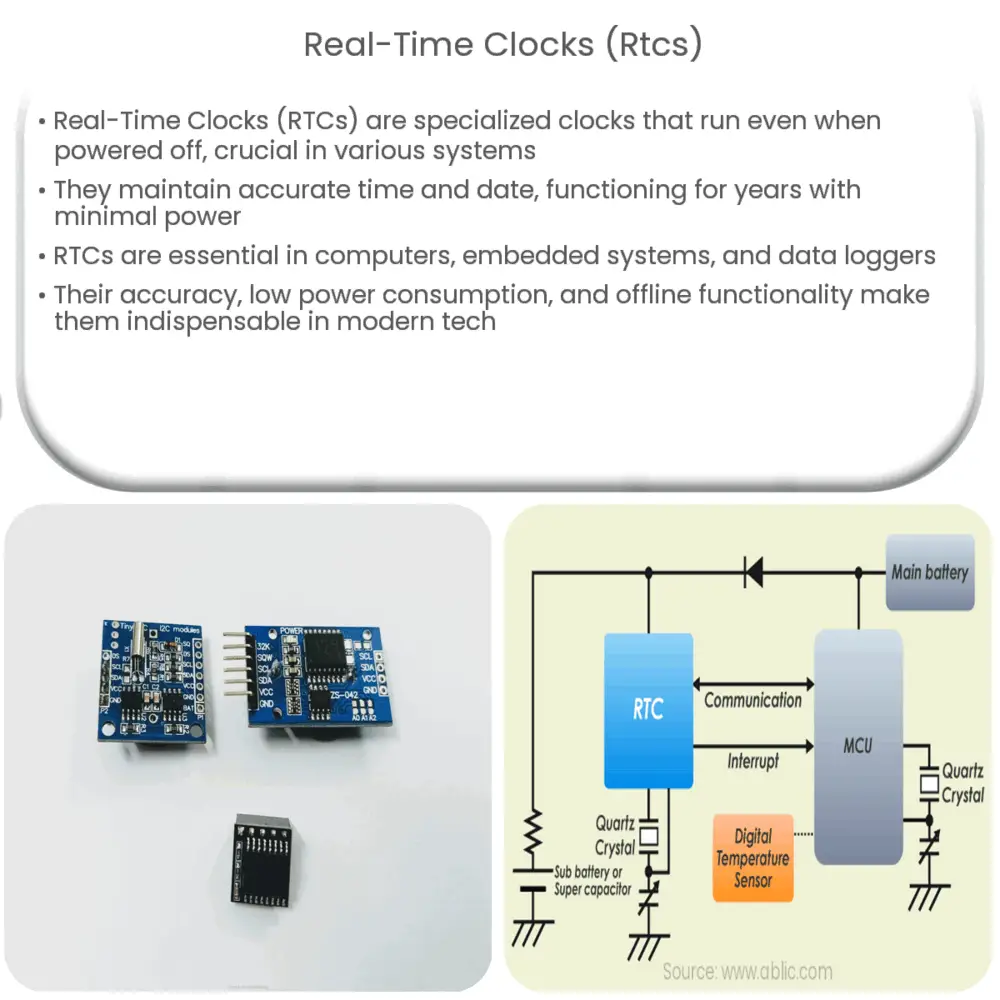Explore the crucial role of Real-Time Clocks (RTCs) in modern technology, their working principle, types, and widespread applications.

Introduction to Real-Time Clocks (RTCs)
A Real-Time Clock (RTC) is a computer clock that keeps track of the current time. It’s not just any ordinary clock, but a specialized one that runs even when the system is powered off. This ability makes it an indispensable component in a variety of systems.
Modern RTCs are usually present on the motherboard of computers, embedded systems, and servers. They are highly precise and designed to consume minimal power, allowing them to function for several years with a small battery. The primary function of an RTC is to maintain accurate time, date, and often, other information like day of the week.
Working Principle of RTCs
Inside an RTC, a crystal oscillator serves as the heart of the timekeeping function. It uses the mechanical resonance of vibrating crystal to create an electrical signal with a precise frequency. This allows the RTC to accurately keep time, often down to the second.
Applications of RTCs
-
Computers and Laptops: RTCs in these devices keep track of time and date, even when they’re turned off. When you boot your system, the operating system reads the RTC to get the current time and date.
-
Embedded Systems: Many embedded systems like digital cameras, GPS devices, and home automation systems use RTCs to timestamp events or to perform tasks at certain times.
-
Data Loggers: RTCs play a crucial role in data logging devices, which need to record the exact time when data is collected. This is particularly useful in scientific experiments, environmental monitoring, and industrial processes.
Importance of RTCs
RTC’s accuracy and reliability make it a pivotal component in maintaining the functionality of many systems. Despite the widespread adoption of network-based time servers and protocols such as NTP (Network Time Protocol), RTCs maintain their place in modern technology due to their ability to function offline, independence from network latency, and minimal power requirements.
RTC’s role becomes even more prominent in remote, stand-alone systems that need to maintain accurate time but have inconsistent or no network access. Examples of such systems include deep-sea data loggers, forest fire detection systems, and space satellites.
Types of Real-Time Clocks (RTCs)
There are various types of RTCs, each designed to cater to different requirements. Here are a few common ones:
-
Battery-backed RTCs: These RTCs have a separate lithium battery which powers the clock even when the main power supply is turned off. This design allows the RTC to maintain accurate timekeeping for several years.
-
Capacitor-backed RTCs: Instead of a battery, these RTCs use a capacitor for power backup. While they tend to have shorter backup duration compared to battery-backed RTCs, they are often chosen for their longer lifespan and eco-friendliness.
-
Crystal RTCs: These RTCs use a crystal oscillator for timekeeping. They offer high accuracy and stability and are commonly used in computers and embedded systems.
Integration of RTCs
Many RTCs today are integrated into microcontrollers and system-on-chip (SoC) designs. This reduces the need for external RTCs and makes the design of digital devices more streamlined. However, standalone RTC modules are still widely used in various applications that require high precision or have specific power requirements.
Conclusion
In conclusion, Real-Time Clocks (RTCs) serve as the unsung heroes in our digital world, quietly keeping time in the background of our devices. From powering your computer’s internal clock to enabling time-critical functions in industrial processes, RTCs are fundamental to many aspects of modern life. Their low power consumption, high accuracy, and the ability to function offline make them an irreplaceable component in a broad range of applications.
As technology continues to evolve, the importance of RTCs remains unwavered. Whether it’s in a personal laptop, a remote sensing device in the middle of the ocean, or a satellite orbiting in space, RTCs are there, ticking away, ensuring that our digital world functions accurately, effectively, and always on time.

